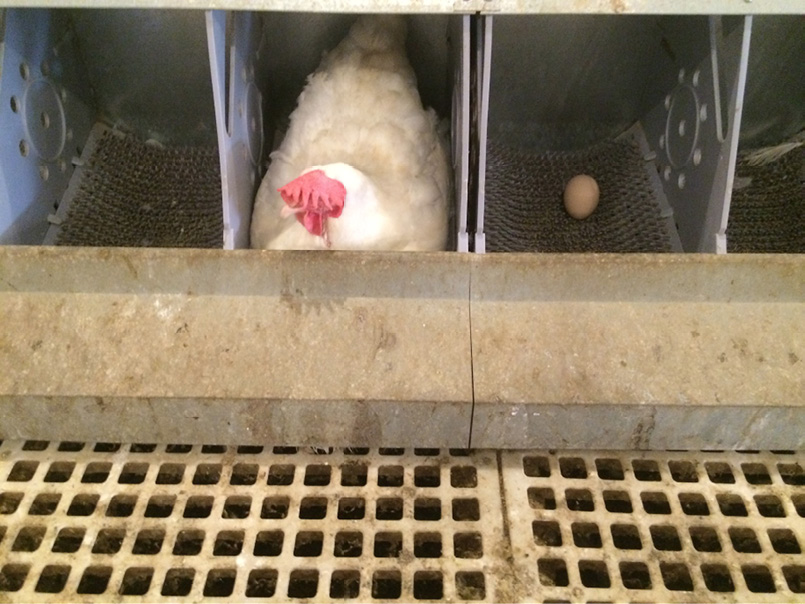Keys to Successful Handling of Hatching Eggs
The goal of every broiler breeder grower is to produce a quality hatching egg that will produce a good-quality baby chick. This may sound simple in theory, but the reality is that it takes a great deal of time and hard work to successfully accomplish the task. To consistently achieve this goal, a producer must understand how to take care of a hatching egg.
Egg Shell Structure
Understanding the structure of an egg is the first step in protecting and caring for that egg. While it may appear that the shell is a solid protective covering for the embryo, upon closer examination, the shell is not solid at all. There are thousands of tiny pores in the egg shell that are necessary for respiration of the developing embryo.
After calcification of the shell, a mucous membrane, called the cuticle, is coated over the egg, providing protection to the porous shell. The hatching egg is at its highest quality at the time it is laid. The egg will not gain quality after being laid; however, it can lose quality rapidly depending on how it is handled. Therefore, it is critical that you do all you can to protect the cuticle. The cuticle protects the embryo from outside bacteria and keeps the embryo from losing too much moisture.
Bacterial Contamination
What happens if the cuticle is compromised and harmful microorganisms penetrate the porous shell and enter the egg? If the microorganisms are gas-producing bacteria, an exploding egg will result. An exploding egg inside the incubator or hatcher can cause additional contamination as the contents of the exploding egg are sprayed onto other eggs nearby. Many of today’s commercial hatcheries are equipped with an in ovo vaccine injection system that results in an obvious hole in the shell through which bacteria from exploding eggs can easily penetrate nearby eggs.
How can broiler breeder growers lessen the chance of having bacterial contamination on hatching eggs they send to the hatchery? Do all you can to keep the eggs clean and dry and to keep the protective cuticle intact. To keep eggs clean, collect them at least four times a day, 7 days a week. Keep in mind that the goal is to minimize the time the egg remains in the nest or on the belt after it is laid. If eggs are collected at least four times daily, there will be less opportunity for the hens to crack or soil them. In addition, collecting eggs at least four times daily will mean less exposure time of eggs to unfavorable environmental conditions. Depending on the environmental temperature, the egg may be exposed to high or low temperatures, causing improper embryonic development.
To decrease the risk of bacterial contamination, keep the egg table, collection belts, and nest pads as clean as possible. Clean the egg table after each collection and clean the belts of broken eggs as they are found to reduce the chance of soiling additional eggs. Run the belts frequently to minimize debris buildup. Keep nest pads as clean as possible. Before hens begin to lay eggs, use nest closures or raise the nests to prevent birds from roosting in the nests and getting the nest pads dirty. Remove nest pads and shake them out as needed to remove any debris that may contaminate freshly laid eggs.
Strive to keep floor and slat eggs at a minimum. Develop a routine of walking the birds at the same time every day to condition them and help minimize floor and slat eggs. Initiate this practice from the first day the hens arrive. Provide adequate nesting space to decrease the number of floor and slat eggs. Monitor light levels and make sure light uniformity is close to the same throughout the house. Hens tend to seek out dark areas to lay eggs, so minimize the number of shadows or dark areas within the chicken house to keep the hens laying in the nests.
There is a great deal of expense invested in broiler breeder chickens (Figure 1; initial chick purchase cost, feed cost, vaccination cost, etc.). Broiler breeder hatching eggs are very valuable, so most commercial broiler companies stress the importance of salvaging as many clean hatching eggs as possible. However, there are limits as to what are acceptable practices where clean eggs are concerned. Realize that sanding or buffing eggs can remove the protective cuticle covering and may grind dirt and microorganisms into the eggs’ pores. If you use buffing practices, make sure that all the materials you use are clean and dry. If an egg requires more than two or three wipes to remove fecal material or dirt, it is too dirty to be considered a quality hatching egg and should not be set.

Keeping eggs dry is an important step in decreasing bacterial contamination. Wetting hatching eggs with or without disinfectants can result in contamination. Any concentration of moisture on warm eggshells evaporates, thus cooling the eggs. This cooling effect lowers the internal pressure, pulling contaminants through the pores and into the eggs. Many bacteria use moisture as a vehicle to literally swim into eggs. Do not allow eggs to sweat. Going from cool to warm temperatures can cause egg sweating. Never move buggies with eggs out of the egg storage room into the workroom. Never wash or wipe eggs with a wet cloth at the farm.
Cool cells and foggers may be used to maintain comfortable temperatures during summer months. Fogging, especially if done improperly, can lead to a high level of contamination in the egg pack. If you use foggers, make sure your fogger nozzles are positioned correctly so that they don’t produce excess condensation that might drip onto the litter or wet the litter directly. Keeping the litter dry is of vital importance to keeping the eggs clean. Wet litter can act not only as a source for more microorganisms, but it can also stick to the hens’ feet and be carried into the nests, leading to dirty nest pads, eggs, and egg belts.
Another important litter characteristic to consider is the depth of the litter in the scratch area. If the litter in the scratch area is not deep enough and the litter cakes over, wet litter will then be tracked into the nests on the hens’ feet. Maintain plenty of dry, loose litter in the scratch area, and manage ventilation and humidity levels to keep it dry.
Other Egg-Handling Procedures
Decreasing bacterial contamination is not the only management practice associated with broiler breeder operations. You must also follow some other procedures to produce good-quality hatching eggs. You must keep eggs cool. Place eggs in an already cooled egg room. Never place egg buggies in direct line with a heater or cooler. Allow adequate ventilation in the egg room, and leave ample space for air to circulate between the buggies and between the buggies and the walls. Remember, never remove eggs from the cooler as this can cause egg sweating; leave them in the cooler until it is time for them to go to the hatchery. Keeping the eggs cool will help delay embryonic development. This is important because producers must often store eggs on the farm for several days.
Always place eggs in buggy trays with the small end down and the large end up. The air cell of the egg is located at the large end. The embryo uses this end for respiration the last day or two of incubation, so keeping this orientation is critical for hatching.
As you collect eggs, fill the egg buggies from the bottom rack to the top rack. Heat rises, so placing warm eggs below cool eggs may cause preincubation. After picking up mortality, always wash your hands before collecting eggs.
Often eggs may not roll onto the belt for collection after they are laid (Figure 2). When picking up mortality or floor/slat eggs, make it a point to check the nests and gently roll these eggs onto the belt so that they may be collected at the next collection. This practice will help prevent the embryo from entering early development, and it will decrease the chances that the egg will be cracked or soiled by the next hen to use the nest.
Keep the egg room and workroom as clean as possible. Use the egg room only for storing eggs and buggies. Do not use it as a storage room for tools, boxes, or farm equipment. These things will collect dust and attract rodents and insects, which can spread contamination and disease. Never put cracked eggs in the egg buggies. Cracks increase the potential for bacteria to enter and produce exploding eggs.
Make sure all visitors, even company personnel, wear disposable boots and coveralls when entering your breeder houses. Provide clean footbaths containing disinfectant at each entrance. Biosecurity is extremely important today, so allow only necessary and authorized visitors onto your farm and into your chicken houses.

Summary
One of the most important aspects of producing good-quality hatching eggs is to educate yourself and your employees on proper egg collection and storage techniques. If everyone involved in egg handling is not familiar with the proper procedures for producing good-quality hatching eggs, poor egg quality will result. Remember that a good-quality egg usually means a good-quality chick.
The information given here is for educational purposes only. References to commercial products, trade names, or suppliers are made with the understanding that no endorsement is implied and that no discrimination against other products or suppliers is intended.
Publication 3788 (POD-10-21)
Revised by Tom Tabler, PhD, former Extension Professor, Poultry Science, and Jessica Wells, Assistant Clinical/Extension Instructor, Poultry Science, from an earlier edition by Sue Ann Hubbard, former Clinical Professor, Pathobiology and Population Medicine, MSU College of Veterinary Medicine.
The Mississippi State University Extension Service is working to ensure all web content is accessible to all users. If you need assistance accessing any of our content, please email the webteam or call 662-325-2262.




